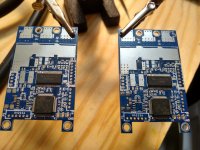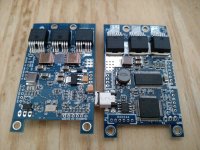torqueboards
1 MW
Wow nice photo! That looks awesome..





torqueboards said:560uF 63v for the Caps on the CapPCB and/or you can use a single 2200uF 63v if you didn't want to go the smaller 3 caps. Brand is Nichicon.
You can also find the files in the github and upload to Oshpark.
Ptown_Cruiser said:@Chaka: I saw that you very graciously posted your 4.10 gerbers for OshPark a while back. I am planning on placing an order to OshPark soon and I am going to try my hand at soldering a vesc (I am just going to be soldering one, but it seems like the cheapest option is still to buy 3 from OshPark). I was wondering if you would be willing to post your gerbers for the 4.12 version? I figured I might as well do the most up to date version, but you said that you have to modify the files, and I would hate to screw that up and blow $40 for nothing! I am also going to be ordering the cap boards that you submitted a design for, may I ask what size caps you generally use for that? Again, a big thanks to you (and everyone else behind the vesc, esp. Vedder) for your willingness to share and help out the community.


chaka said:If you are only assembling a few VESC's film stencils will work but nothing beats the ease of these stainless stencils.


torqueboards said:@silviasol - There's tons of places for stencils ranging from $20 - $50 / piece depending on the material. I"m sure, you knew that already.
rmrf said:I just soldered my first VESC. Bought boards at oshpark. Components at Mouser. HW 4.10. Successfully uploaded bootloader with ST-Link and "make upload" (got "verified ok" message in the terminal), then disconnected 6pin cable and connected VESC to the battery 5S LiPo (18.5V). Unfortunately it does not show any signs of life. No LEDs are blinking. How do I diagnose the problem? Where do I start?
Front:

Back:

Larger images are here http://vedder.se/forums/viewtopic.php?f=7&t=195
